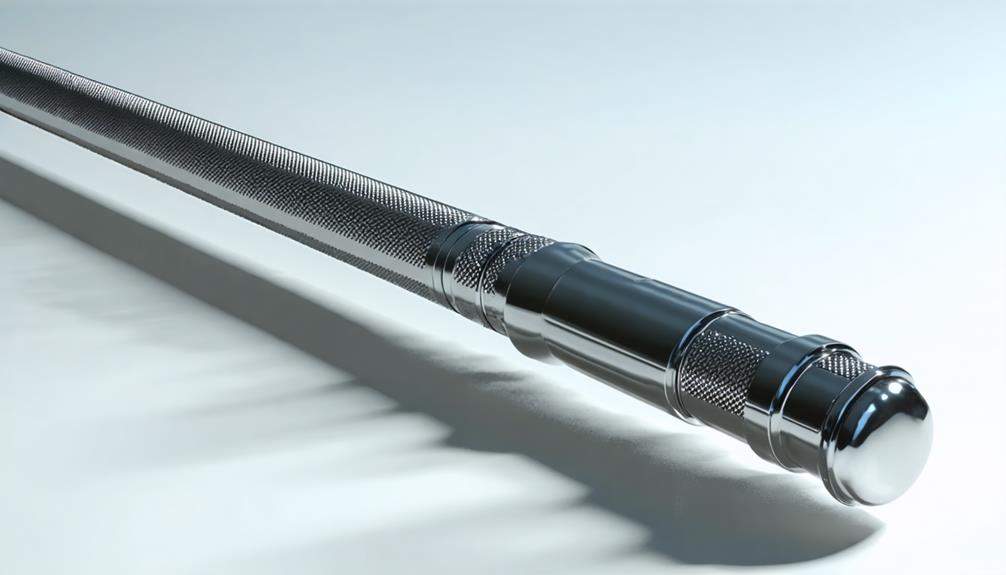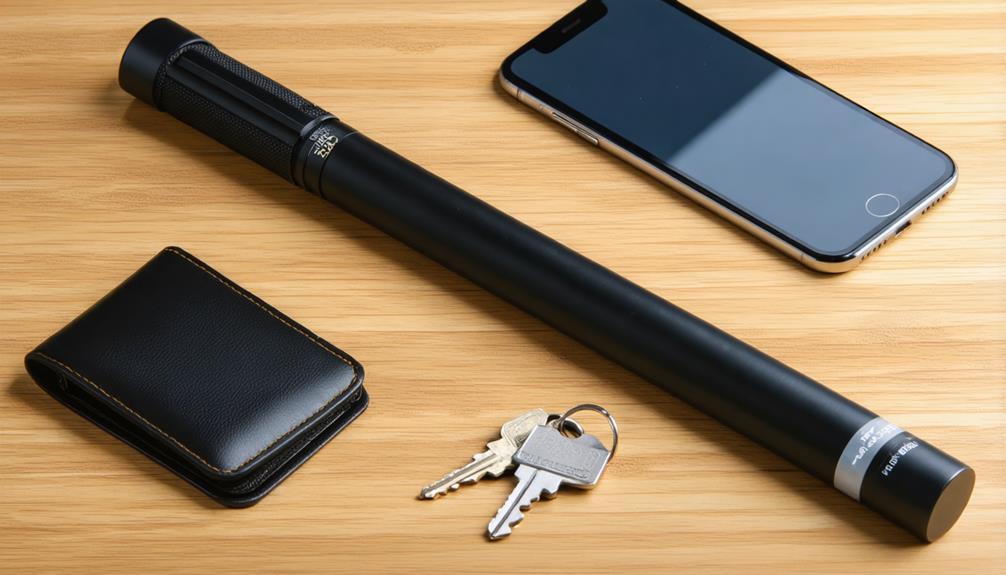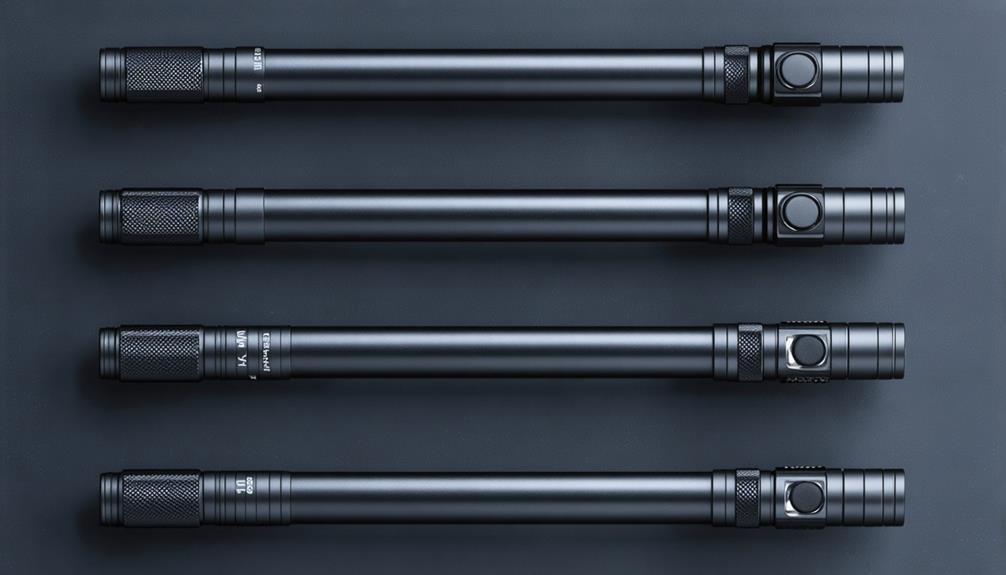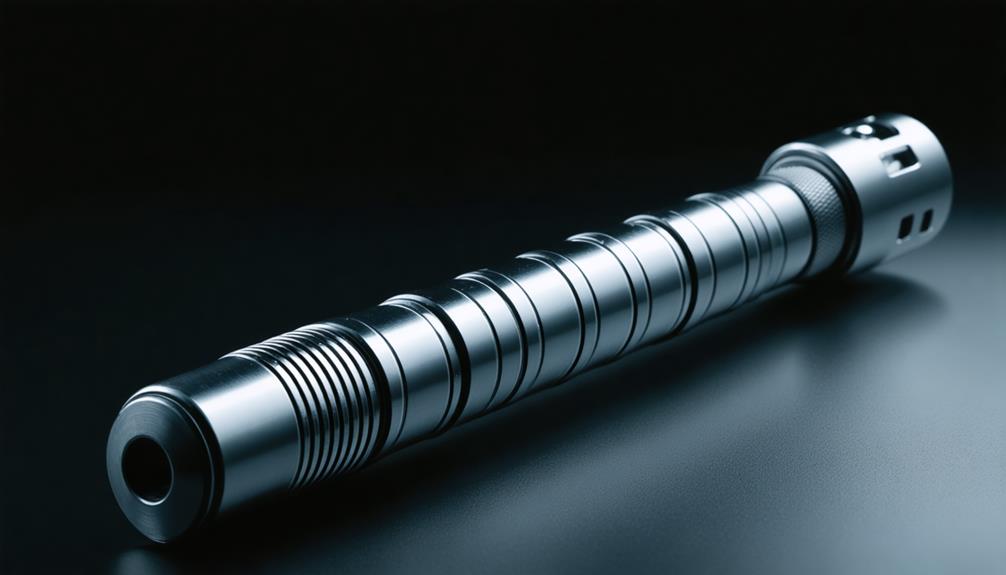
Brainstorm Security Shop

For Orders Over $199

On Any Of Our Products

Details On Refund Page
The push button expandable baton represents a significant advancement in personal defense technology, blending rapid accessibility with practical design. As a tool that transcends traditional self-defense methods, its appeal lies in its ability to swiftly transition from a compact form to full extension with a single motion. Crafted from robust materials, it promises durability and reliability, crucial in scenarios where every second counts. However, the baton’s application extends beyond mere functionality, raising intriguing questions about its role within law enforcement and civilian spheres. What implications does its use have on safety and legal frameworks?
Expandable batons, frequently known for their tactical applications, are versatile tools designed for a range of security and self-defense purposes. Their origins can be traced back to ancient times when similar instruments were used by law enforcement and military personnel.
The baton history reveals a progression from simple wooden sticks to sophisticated, modern designs crafted to enhance efficiency and portability. Over the centuries, these tools have evolved significantly, influenced by technological advancements and the changing needs of security professionals.
Today, expandable batons are crafted from various material types, each offering distinct advantages. Common materials include steel, aluminum, and composite polymers.
Steel batons are renowned for their durability and strength, making them a preferred choice for heavy-duty applications. Aluminum, on the other hand, offers a lightweight alternative, facilitating ease of use without significantly compromising strength.
Meanwhile, composite polymers provide an innovative option that combines lightness with high resistance to impact and wear. The selection of material types is crucial as it influences the baton’s weight, balance, and overall effectiveness.
As a result, the choice of material is often tailored to specific operational requirements and user preferences, underscoring the baton’s adaptability.
With a firm understanding of the material composition and historical evolution of expandable batons, we now turn our attention to their key features and benefits.
Modern push button expandable batons have undergone significant design innovations, making them indispensable tools for law enforcement and personal security. A crucial feature includes the swift deployment mechanism, allowing the baton to extend instantaneously at the push of a button, ensuring readiness without compromising safety.
User testimonials often highlight several aspects that make these batons favorable:
These features collectively enhance the baton’s functionality, aligning with modern demands for practicality and efficiency.
In an ever-evolving landscape of safety tools, design innovations have positioned the push button expandable baton as a reliable and effective option, as corroborated by numerous user testimonials.

Understanding the mechanics behind the push button expandable baton is essential for users seeking to maximize its efficacy. This tactical tool relies on a sophisticated mechanism operation that allows for rapid deployment and retraction. At its core, the baton consists of telescoping sections, each housed within the other, and a spring-loaded push button that controls their extension.
When the button is pressed, the internal spring mechanism releases the segments, which lock into place to form a rigid, extended baton. This seamless operation is crucial for the swift response required in high-pressure situations, ensuring the baton is ready for immediate use.
Proper maintenance is key to ensuring the baton remains in optimal working condition. Regular cleaning is recommended to prevent debris from interfering with the mechanism operation.
Users should periodically disassemble and inspect the internal components, lubricating moving parts to maintain smooth functionality. It is also advisable to check for any signs of wear or damage, particularly around the locking joints and push button, as these areas are critical to the baton’s performance.
The push button expandable baton offers significant tactical advantages for law enforcement officers by providing a compact, easily deployable tool that enhances their ability to manage confrontational situations effectively.
Its design contributes to officer safety by allowing for rapid extension and retraction, thereby minimizing response time and reducing exposure to potential threats.
Comprehensive training and deployment methods are essential to ensure that officers can maximize the baton’s benefits while adhering to legal and ethical standards.
Incorporating push button expandable batons into law enforcement arsenals offers significant tactical advantages. These modern implements are designed for quick deployment, making them invaluable in self defense scenarios and various tactical situations.
Their design allows officers to respond promptly to threats, providing an immediate non-lethal option that can be employed with precision and control. The adaptability of these batons ensures law enforcement personnel can effectively manage encounters without escalating to more severe measures, which is crucial in maintaining public safety and officer efficiency.
The tactical advantages offered by push button expandable batons can be summarized as follows:
These features collectively enable officers to maintain a tactical edge, adapting swiftly to evolving situations.
Officer safety is significantly enhanced by the integration of push button expandable batons within law enforcement operations. These modern tools provide officers with a reliable, non-lethal option to manage confrontational situations, thereby reducing the risk of injury to both the officer and the subject involved.
The ease of deployment offered by the push button mechanism ensures that officers can react swiftly in high-pressure scenarios, augmenting their ability to employ effective self defense techniques. This rapid response capability is crucial in maintaining control and ensuring officer safety in volatile environments.
In addition to their operational advantages, the maintenance of push button expandable batons is straightforward, requiring minimal effort to ensure their readiness. Regular baton maintenance involves simple inspections for wear and tear, ensuring the mechanism functions correctly and reliably when needed.
This diligence in maintenance fosters confidence in the equipment, allowing officers to focus on tactical decisions rather than equipment reliability.
Law enforcement agencies frequently emphasize the importance of comprehensive training and deployment methods to effectively utilize push button expandable batons.
These batons, known for their swift deployment and tactical advantages, require officers to be well-versed in various deployment scenarios and adept in training techniques that ensure both their safety and the safety of the public.
Effective training programs are structured around realistic simulations to prepare officers for diverse situations.
Key components of these programs include:

As the popularity of self-defense tools continues to rise, the push button expandable baton has emerged as a viable option for civilians seeking personal protection. Its compact design and ease of use make it an attractive choice for those concerned with personal safety. Unlike traditional batons, this modern tool can be easily expanded with a simple push, allowing for quick deployment when needed. Civilian users can incorporate the baton into various self-defense techniques, enhancing their ability to protect themselves in a threatening situation.
The push button expandable baton offers several advantages in civilian applications, highlighted in the table below:
| Feature | Benefit | Application |
|---|---|---|
| Compact Design | Easy to Carry | Everyday Use |
| Quick Deployment | Immediate Readiness | Emergency Situations |
| Durable Material | Long-lasting | Frequent Use |
| Non-lethal Force | Reduces Injuries | Self Defense |
| Cost-effective | Affordable Access | Wide Availability |
This tool empowers individuals to feel more secure in their daily lives. By incorporating the baton into their personal safety strategies, civilians can enhance their preparedness without resorting to more lethal methods. The push button expandable baton thus serves as an essential component in the growing landscape of self-defense options available to the public.
When considering the use of push button expandable batons, it is crucial to be aware of legal carry restrictions, which vary significantly across jurisdictions.
Understanding these laws ensures compliance and prevents potential legal repercussions.
Additionally, adhering to proper usage practices is essential to enhance safety and effectiveness while minimizing the risk of injury or misuse.
Navigating the legal landscape surrounding the carry of push button expandable batons can often be complex, with regulations varying significantly across different jurisdictions.
State laws play a crucial role in determining whether an individual can carry such a baton, often requiring specific carry permits. These permits may outline conditions under which a baton can be carried, especially in self-defense scenarios or during emergency situations.
However, these regulations are not uniform, leading to notable regional differences that can affect the legality of carrying a baton, particularly on public transport.
Key considerations include:
Understanding ownership rights and the potential legal penalties for non-compliance is essential for anyone considering carrying a push button expandable baton.
It is advisable to consult local legal counsel to ensure compliance with all relevant laws. This approach not only safeguards the individual’s legal standing but also ensures responsible and informed ownership.
To ensure both safety and legal compliance, individuals must understand the proper usage practices of push button expandable batons. Familiarity with techniques for deployment is crucial to avoid unintended harm or escalation during self-defense scenarios. Users should be trained to deploy the baton swiftly and accurately, ensuring it is done only in situations where it is legally justified and necessary for personal safety. Practicing controlled and precise movements helps in gaining proficiency and confidence, minimizing the risk of accidental injury to oneself or others.
Furthermore, regular maintenance practices are essential to guarantee the baton’s reliability and longevity. Routine checks should include examining the mechanism for any signs of wear or malfunction, which could impair its effectiveness. Cleaning the baton, particularly after exposure to adverse conditions, will prevent corrosion or blockage of the push button system. Lubricating moving parts with appropriate products can ensure smooth operation and prevent jamming.
Importantly, users must also be aware of the legal framework governing the use of batons in their jurisdictions, as misuse can lead to severe legal consequences. Adhering to authorized use and keeping abreast of any legislative changes is paramount for responsible ownership.

Selecting the appropriate expandable baton involves assessing various factors to ensure it meets your specific needs and expectations. One of the first considerations is the baton materials, as these determine the durability and effectiveness of the tool. Common materials include steel, aluminum, and composite materials, each offering unique benefits.
Steel batons are known for their robustness, while aluminum batons are lighter and easier to carry. Composite materials provide a balance between strength and weight.
Another critical factor is baton sizes, which affect the ease of handling and the baton’s reach. Typically, batons range from 16 to 26 inches when extended. A shorter baton may be more convenient for concealment and quick deployment, whereas a longer baton offers extended reach and potentially more impact.
When choosing a baton, consider the following:
Proper maintenance and cleaning of an expandable baton involve understanding the baton materials and applying appropriate cleaning techniques. Regularly inspect for damage, use mild soap with water, and lubricate hinges to ensure optimal performance and longevity.
Expandable batons can be integrated into self-defense training, enhancing skills and techniques. However, legal considerations must be assessed, as regulations vary by jurisdiction regarding their use and possession in self-defense situations or training environments.
Yes, various accessories are available for expandable batons, including holsters and grip enhancements. When selecting accessories, consider the baton types and ensure they comply with safety regulations to maintain operational integrity and user safety.
The average lifespan of an expandable baton largely depends on baton durability and usage frequency. Regular use and harsh conditions may reduce its lifespan, while careful maintenance and infrequent use can significantly extend its functional longevity.
Expandable batons necessitate specific storage considerations to maintain functionality and longevity. Safety precautions include storing in a dry, secure location away from extreme temperatures to prevent material degradation and ensure readiness for use when required.
The Push Button Expandable Baton represents a significant advancement in personal defense tools, offering rapid deployment and ease of use. Its durable construction and ergonomic design ensure reliability and comfort, making it suitable for both law enforcement and civilian applications. The baton provides a non-lethal solution for effective threat management, balancing safety and functionality. Awareness of legal considerations is crucial when selecting the appropriate baton, ensuring compliance with regulations while enhancing personal security in various environments.

Brainstorm Security Shop
1867 Caravan Trail
Ste 105
Jacksonville, FL 32216
Call us toll free: (800) 859-5566